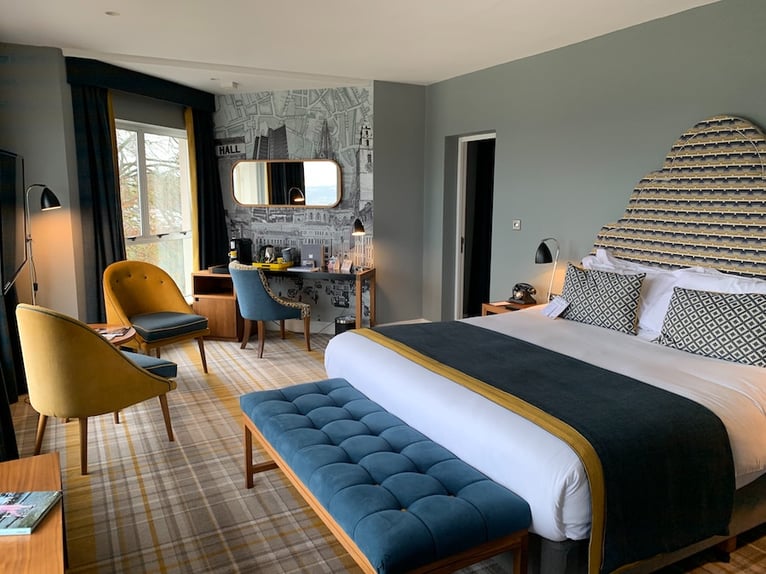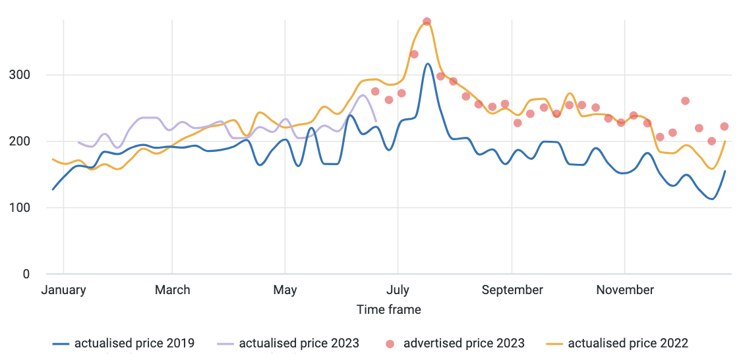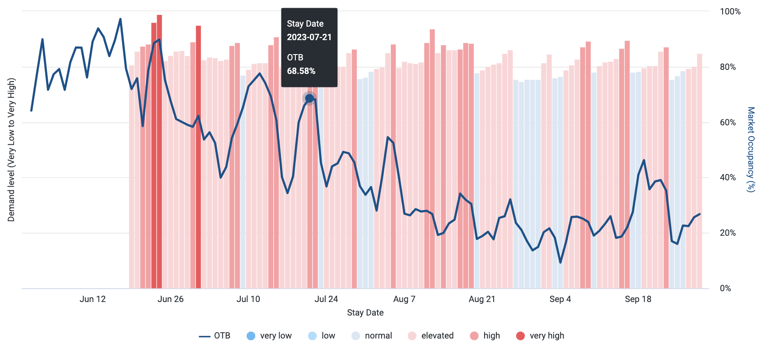
Read our expert guide on RevPAR: Find out what it is, and learn how to calculate and optimise it at your hotel.

In the highly competitive world of hospitality, it's crucial for you to understand and analyse the key performance indicators regarding hotel revenue.
One such metric that holds significant importance is Revenue per Available Room (RevPAR), it is the most commonly used metric by hotel revenue managers and provides an incisive snapshot of your hotel’s revenue performance.
In this blog post, we'll delve into the intricacies of RevPAR, explore its use in driving hotel revenue, and provide insights on optimising this essential metric to maximise your property's revenue potential.
What is RevPAR?
RevPAR, an acronym for Revenue per Available Room, is an indispensable metric for hoteliers worldwide looking to assess their properties revenue performance.
Unlike other revenue metrics that focus solely on the room rate or occupancy, RevPAR provides you with a comprehensive picture by combining both elements.
By calculating RevPAR, you gain valuable insights into how effectively your rooms are generating revenue and, subsequently, evaluate your property's overall financial health.
RevPAR isn’t your average performance indicator, it’s the gold standard in measuring the effectiveness of hotel revenue (and to a lesser extent) marketing strategies, and outshines the more conventional Average Daily Rate (ADR) metric.
So let's dive into calculating RevPAR and see how it works.
One straightforward formula to calculate RevPar is dividing the total number of rooms available in your hotel with the total revenue from the night:
RevPAR = Total Revenue per night ÷ Total number of Rooms
Picture this: you have a delightful boutique hotel with ten rooms, each night your hotel brings in an average income of $2000. With a quick calculation of $2000 ÷ 10, your RevPAR stands at $200.

There's also another approach to calculating RevPar, which returns the same final outcome, where we welcome the dynamic duo of Average Daily Rate (ADR) and Occupancy Rate to the stage.
ADR signifies the amount you charge per room, while the Occupancy Rate is how many rooms are sold.
Here RevPAR is calculated by multiplying ADR by Occupancy Rate:
RevPAR = Average Daily Rate (ADR) × Occupancy Rate
Imagine you usually set your room rate at $300, and your occupancy rate is at a healthy 80%. In this scenario, with a quick calculation of $300 × 0.8, RevPAR sits at $240.
This formula accounts for both occupancy and average daily rate (ADR), allowing hoteliers to understand the revenue contribution from each available room.
RevPAR serves as a barometer for hotel performance, reflecting the property's ability to maximise both occupancy and pricing. It is a concise, reliable, and actionable measure of financial performance.
It enables you to identify trends and forecast, benchmark against competitors, and take informed pricing decisions.

By focusing on RevPAR, you can optimise revenue streams, drive profitability, and achieve sustainable growth.
A change in your RevPAR could indicate that your strategy needs adjusting, and you would need to introduce measures to turn that around. Increasing your occupancy or your ADR will lead to an increase in RevPAR, though any decision you make must take into account your overall profitability.
If you increase your ADR by too much, you risk lowering your occupancy and if you only focus on increasing your occupancy, you risk lowering your prices.
Leveraging RevPAR for hotel revenue optimisation with yield management and dynamic pricing
Yield management is a broad concept that encompasses various strategies and techniques (including dynamic pricing), to optimise revenue from a fixed and limited resource, i.e. hotel rooms.
Yield management takes a holistic approach to hotel revenue optimisation, considering not only room pricing but also factors like inventory availability, customer segmentation, and market conditions.
It aims to maximise revenue by selling the right room to the right customer at the right time for the right price. Yield management strategies are based on the understanding that demand for a product or service can vary over time, and that different customer segments are willing to pay different prices.
Dynamic pricing is a key tactic used within yield management to achieve this goal. Dynamic pricing refers to the practice of adjusting hotel room rates in real-time based on various factors and market conditions.
It involves setting prices that are flexible and can change dynamically to optimise revenue and maximise occupancy rates.
Hotels use dynamic pricing strategies to respond to changes in supply and demand, market trends, competitor rates, and other factors that can influence booking patterns.
Events can dramatically influence booking patterns in your market. Below are two charts using OTA Insight data, looking at hotel pricing and market occupancy for San Diego, USA - with a focus on the city's biggest event, San Diego Comic Con, taking place from 20-23 July, with 135,000 likely in attendance.
During Comic Con advertised hotel room prices are peaking at $379 in San Diego, which is roughly $100 higher than the weeks either side of the event. While market occupancy in San Diego is already over 68% for Comic Con dates.
It is crucial that you take advantage of events like these and maximise your revenue with optimal room pricing.
Hotel room pricing for San Diego across all star ratings (USD)

Market occupancy and demand level for San Diego

By constantly monitoring and analysing these various factors, such as events, you can adjust your prices accordingly to meet market demand. But, manually monitoring all these elements would take a prohibitive amount of time.
By using a pricing recommendation tool like Pricing Assistant your room pricing is automated with tailored and transparent recommendations. So you can easily make better pricing decisions and invest your time where it is needed the most.
With pricing recommendations that take into account your own occupancy, market occupancy, and compset prices, you can fully optimise RevPAR at your property.
Unlocking profitability with descendants of RevPAR
RevPAR has long been the go-to KPI for commercial team’s when analysing hotel revenue performance, but as you know, profit is the ultimate goal.
That's why related metrics have emerged, offering different perspectives on measuring hotel performance, in terms of growth, profit, and revenue.
ARPAR: Fine-tuning revenue management
Adjusted Revenue per Available Room (ARPAR) goes a step further in measuring a hotel's performance.
By factoring in revenue, costs per occupied room, and additional revenue streams, ARPAR offers a comprehensive evaluation of revenue management and the effectiveness of pricing policies.
ARPAR accounts for the costs associated with each occupied room, including cleaning, energy usage, water consumption, internet and TV services, and supplies like toiletries.
The ARPAR formula allows for the subtraction of various costs, enabling a more accurate assessment of profitability.
ARPAR = Average (Income per night – Variable costs per night) ÷ Total number of rooms
TrevPAR: Maximising revenue potential
TrevPAR, short for total revenue per available room, takes a more holistic approach by considering the total revenue generated across all areas within your hotel. From the spa to optional breakfast, TrevPAR captures the bigger picture.

TrevPAR provides valuable insights for accountants, hotel owners, and general managers seeking a high-level overview of profitability.
TrevPAR = Total Revenue ÷ Total Number of Rooms
However, revenue managers may find it less useful as it fails to isolate specific revenue streams, limiting your ability to optimise room revenue.
GOPPAR: Unveiling comprehensive performance
Gross Operating Profit per Available Room (GOPPAR) provides a thorough depiction of a hotel's performance.
This metric considers all rooms, irrespective of occupancy status. It can serve as a reliable indicator of success across all revenue streams.
However, it also includes variables such as amenity costs and utility bills that commercial team members have little to no control over.
GOPAR = Gross operating profit ÷ (per) Available Room
It is best used to provide a general overview of your property's performance.
These metrics can offer a more nuanced understanding of a hotel's financial performance. But, RevPAR remains the most widely used metric by revenue managers, for good reason.
It provides a straightforward overview of a hotel's revenue performance, generated by room sales, a hotel's core business.
Given its simplicity, focus on room revenue, industry-wide adoption, forecasting capabilities, and ease of calculation, RevPAR has emerged as the preferred metric for hotel revenue managers.
It serves as the number one KPI for you when seeking to maximise revenue potential.
Understanding its calculation and significance empowers hoteliers to make more informed pricing decisions, optimise occupancy, and ultimately drive sustainable profitability.
To fully optimise RevPAR, it is essential you leverage advanced analytics and data-driven insights.
OTA Insight's pricing recommendation tool, Pricing Assistant, streamlines your revenue management process by automating dynamic room pricing at your property, increasing your revenue and giving you a vital edge over the competition.
About OTA Insight
OTA Insight empowers hoteliers to make smarter revenue and distribution decisions through its market-leading suite of cloud-based business intelligence solutions including Rate Insight, Parity Insight and Revenue Insight. With live updates, 24/7 support from our customer success team, and a highly-intuitive and customizable dashboard, the OTA Insight platform integrates with other industry tools including hotel property management systems, leading revenue management systems and data benchmarking providers. OTA Insight's team of international experts are based all over the world, including the UK, US, France, Germany, Belgium, Spain, Italy, Brazil, Mexico, Singapore, Australia and India, and supports more than 40,000 properties in 168 countries. Ranked one of 10 “Ones to Watch” in the Sunday Times Tech Track 100, OTA Insight is widely recognized as a leader in hospitality business intelligence.
For more information, visit www.otainsight.com and follow us on Twitter @otainsight.